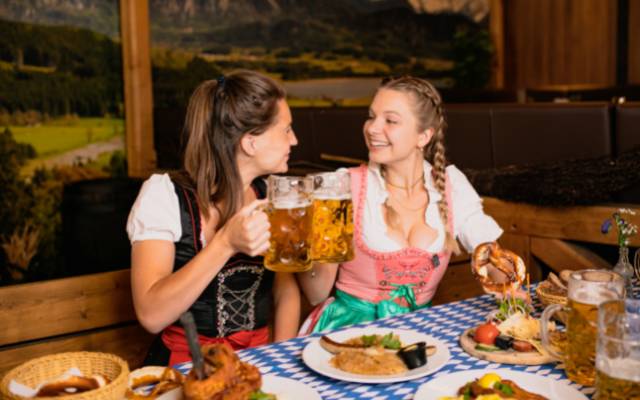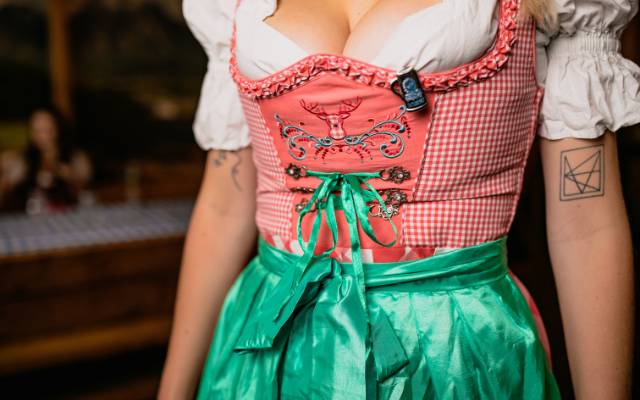What is a Dirndl?
A dirndl is a traditional dress worn in Austria and southern Germany, particularly in Bavaria.
The dirndl typically consists of a bodice, an accompanying dirndl blouse, a skirt, and an apron. It is often associated with Bavarian folk culture and is often worn to festivals and other celebrations.
The dirndl originated in the 19th century as a form of rural working clothing but has since evolved into a popular folk costume.
Whilst traditionally quite plain, the Dirndl is now famed as a wonderfully colourful outfit and is most well-known for its very prominent appearances at events such as the Oktoberfest in Munich each year.
So, the question of What is a Dirndl is revealed fully in this article, and you’ll find out everything you need to know about this traditional Bavarian type of dress. We hope you find the read interesting.
What is a Dirndl Made Of?
As a Dirndl was intended as a working garb, the Dirndl was traditionally made of heavier fabrics such as wool and cotton.
Modern dirndls are often made from lighter fabrics such as linen or silk and can also be made from synthetic materials such as polyester.
The Fashion and Design of the DIrndl?
A dirndl outfit typically consists of three main pieces: the dirndl dress, the apron, and the blouse.
The dirndl dress is a form-fitting bodice with a full skirt, often with a low-cut neckline. However, these days, the skirt of the dirndl can be either long or short, depending on the wearer’s preference.
The apron is a rectangular piece of fabric that is worn over the dress and was typically, traditionally white, although now made to complement the differing colours of the more modern dirndl.
The blouse is a separate garment that is worn under the bodice of the dress and is often white or light-coloured, with a high neckline and short sleeves that are often puffed.
The bodice and skirt are often made of a solid-coloured fabric, while the dirndl blouses and aprons are typically made of a patterned or lace fabric.
The dirndl is often decorated with intricate embroidery, ribbons, and other embellishment and certainly, in recent years the dirndl often features more modern designs and colours than did the traditional dirndl.
How Do You Pronounce the Word Dirndl?
The word dirndl is pronounced “dur-n-dull” in English. But you must say it quickly to get the right pronunciation.
Obviously, the pronunciation may vary slightly depending on the speaker’s regional accents and in German, the word is pronounced: “deer-n-dull.”
Is Dirndl a German word or a Bavarian Word?
Dirndl is a German word. It is associated with Bavarian culture and is commonly worn in Bavaria, which is a state in southern Germany.
However, the word itself is not specifically used in any Bavarian Phrases or sentences and is commonly used throughout Germany and the English-speaking world.
What Does Dirndl translate to in English?
The word dirndl does not have a direct translation in English.
The closest English equivalent would be “Bavarian dress” or “Tyrolean dress,” but these terms do not really capture the full meaning of the word dirndl.
In general, it is best to use the word dirndl itself when referring to this type of dress, as it is widely recognized and has no exact English equivalent.

When is it Appropriate to Wear a Dirndl?
Almost anytime is appropriate to wear a dirndl but it is absolutely dependent only on your specific needs. We know some women who like to wear their dirndls every day!
However, It is more commonly worn at festivals and other celebrations, particularly those with a Bavarian or Tyrolean theme.
Some examples of occasions when a dirndl might be worn include Oktoberfest, the Munich Spring Festival, and the Gäuboden Folk Festival.
In general, a dirndl can be worn whenever you want to celebrate Bavarian culture or add a traditional touch to your outfit.
It is also a popular choice for weddings and other formal occasions in Bavarian or Tyrolean regions.
Dirndl Wearing Etiquette
- Because the appeal of the dirndl is its rustic look, plastic dirndls with flashy ornaments are looked down upon.
- Style experts recommend staying away from cheap outfits that one can buy on the street corner; it is better to spend a little more to get a proper outfit.
- To look a correct fit and to be the correct the right size the dirndl should be tightly fitted as it is not an outfit designed to wear “loosely”.
- It is an absolute no-no to wear a dirndl without a blouse.
- Be mindful of your surroundings when wearing a dirndl. In some settings, such as at a traditional festival, it may be appropriate to wear the dirndl in a more casual and playful manner. In other settings, such as a formal event, it may be better to wear the dirndl in a more reserved and respectful way.
- The dirndl is not only recognised as a German Traditional Dress but is in fact also an Austrian Traditional Dress, so it is important to show respect for the culture and history of both Bavaria and Austria. Whilst it’s always fun to dress up when you’re in the Bavarian and Tyrolean regions, you’ll definitely want to avoid wearing a dirndl simply just as a “costume”.
Interesting Facts about the Dirndl
- The dirndl originated in the 19th century as a traditional peasant dress. It was worn by working women in the countryside and was known for its practicality and durability.
- The dirndl was popularized by the Bavarian royal family, who wore it as a casual outfit for hunting and other outdoor activities. This helped to elevate the dirndl from a peasant garment to a fashionable item of clothing.
- The length of the dirndl skirt can indicate the wearer’s marital status. A long skirt is typically worn by unmarried women, while a shorter skirt is worn by married women.
- The apron is probably the most important aspect of the dirndl outfit. It is typically worn over the dress and is tied at the waist. The knot of the apron can also convey information about the wearer’s marital status. A knot on the left side indicates that the wearer is single, while a knot on the right side indicates that the wearer is married or taken.
- The colour and pattern of the dirndl can also convey information about the wearer. Different colours and patterns are associated with different regions of Bavaria and Austria and can indicate the wearer’s origin or family background.
- Countries nearby Bavaria have adopted their own versions of the German Dirndl and in one version or another dirndl dresses can now be found across the alpine regions in the north of Italy as well as extensively across Switzerland and Lichtenstein.
- Outside of Europe, the Dirndl is also popular in many former German colonies as well as in the German communities throughout South America especially those in Venezuela and Argentina.
- The dirndl has undergone many changes and variations over the years. It has been adapted for different special occasions and styles and is now available in a wide range of colours, fabrics, and designs.
- The dirndl, and the male equivalent, the lederhosen, are part of what is generally called a tracht style of garb. Tracht means “what is worn”, but it is only used in reference to traditional outfits.
How Much do Dirndls cost?

The cost of a dirndl can vary depending on a number of factors, such as the quality of the materials, the complexity of the design, and the reputation of the manufacturer. In general, you can expect to pay anywhere from a hundred Euros right up to several thousand Euros for a high-quality dirndl.
Some handmade or custom dirndls can cost even more.
If you’re shopping for a more affordable option, you can find mass-produced dirndls for sale at lower prices at stores such as H&M in Munich and other similar outlets.
Accessorising your dirndl can really bring the best out in your outfit so consider adding hair accessories and jewellery to your shopping cart for that added WOW factor.
It is important to keep in mind that the cost of a dirndl is not always an indication of its quality or authenticity, so be sure to shop around and compare prices before making a purchase.
Our article entitled Second Hand Munich: Top Vintage, Thrift And Resales Stores will likely help you source some bargain outlets for second-hand dirndls in Munich so have a look at that resource if you’re trying to save a few Euros.
What is A Dirndl | The Traditional German Dress
Today, the dirndl is a versatile and fashionable garment that is worn by people of all ages and backgrounds.
These days personalisation seems to be key to presenting yourself in what would be seen as a fantastic looking dirndl – one that truly fits in with your personality.
German clubs and associations across the globe have adopted this traditional dress for many of their formal and fun engagements and festivities and there are few countries where a dirndl is not recognised.
as a side note, there does actually seem to be one exception to wearing a dirndl specifically as a costume and this is the Oktoberfest Dirndl. These days every woman seems to have one, but you can clearly tell the “costumes” from the real, especially when you’re local to the area.
The male version of the Dirndl is the Lederhosen, and we shall cover that outfit in yet another upcoming blog post.
We trust you enjoyed the read and learnt a thing or two about this traditional Bavarian outfit, and we hope you’ll consider reading some of our other articles.
Take care everyone, and again thanks for reading.
Traditional Bavarian Dress | Dress of Germany | Bavarian Traditional Clothing
How To Make A Dirndl?
Making a dirndl can be a challenging project, especially if you are a beginner at sewing. It involves cutting and sewing several pieces of fabric together to create the final garment, which can be difficult if you are not familiar with sewing techniques. Additionally, making a dirndl requires attention to detail and a good sense of design, as the final garment should be well-fitted and attractive. If you have some experience with sewing and are willing to put in the time and effort, you may be able to make a dirndl. However, if you are new to sewing or do not have much experience, it may be best to start with a simpler project before attempting to make a dirndl. However, if you are determined then THIS ARTICLE provides a full step-by-step tutorial.
What Shoes Do I Wear With A Dirndl?
Traditionally, dirndls are worn with sturdy, closed-toe shoes. Your shoes should be comfortable and practical, and provide support for walking and standing for long periods of time. Some people also choose to wear knee-high or ankle-high boots with their dirndl, which can add a fashionable touch to the outfit. When choosing shoes to wear with a dirndl, it is important to consider the occasion and the overall aesthetic of the outfit.
Where To Buy Authentic Dirndl?
In Munich, your best bet when looking for a dirndl is to start by checking out some of the city’s traditional clothing and costume shops, as well as department stores and boutiques that specialise in traditional German fashion. You can also ask locals or tourists for recommendations, or look for online resources or directories that provide information about where to shop for dirndls in Munich. Trust us when we say this – there is no shortage of tradition german dress shops in Munich.

